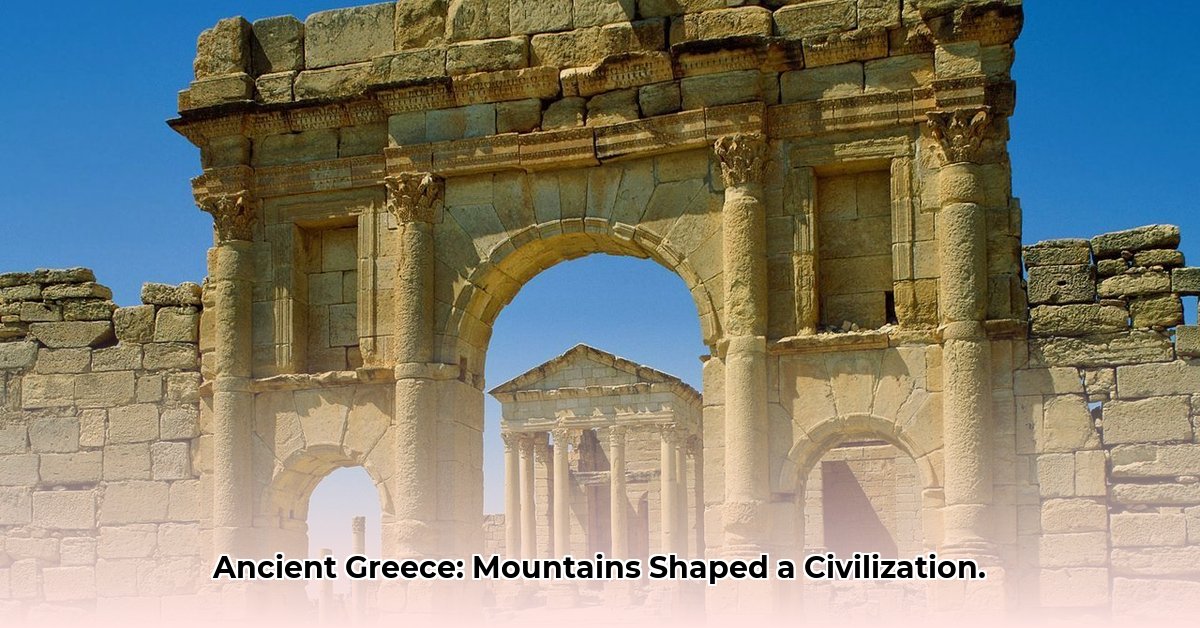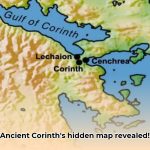Imagine ancient Greece: sun-drenched shores, vibrant city-states, and majestic mountains that sculpted a civilization. These peaks were more than mere geographical formations; they were deeply interwoven with Greek culture, governance, economy, and mythology. This article explores the profound relationship between the rugged Greek mountains and the rise of one of history’s most influential societies. For a detailed overview of Greek geography, see this helpful resource.
The Ancient Greek Landscape: A Symphony of Stone and Sea
A Land Defined by its Terrain
Picture ancient Greece – a world where mountains meet the sea. These land formations were not merely backdrops; they were the very foundation upon which Greek civilization was built, shaping everything from political structures to daily life. Approximately 80% of Greece is mountainous, a factor that fostered resourcefulness, resilience, and unique adaptations. How did these towering peaks influence ancient Greek life and inspire innovation?
The Mountainous Maze: Navigating the Terrain
The Pindus mountain range formed the spine of mainland Greece, influencing weather patterns, settlement distributions, and strategic defense. This challenging terrain fostered resourcefulness and self-sufficiency among communities. Were these mountains natural fortresses, or did strategic mountain passes provide vital access and defensive positions for rival poleis (city-states)? Moreover, the proximity of the mountainous regions to the sea facilitated trade and cultural exchange, creating a dynamic interplay between land and water.
Mountains and the Rise of Independent City-States
The mountainous terrain significantly contributed to the rise of independent Greek city-states, the poleis. The fragmented landscape promoted self-sufficiency and the development of unique laws, customs, and identities within each polis. Yet, the sea served as a vital link connecting these communities, facilitating trade, communication, and cultural exchange. Did mountains primarily cause isolation, or did they, paradoxically, foster interconnectedness through maritime trade? Evidence suggests a complex interplay of both, with mountains both dividing and enabling interaction. As noted by classicist historian Dr. Helena Smith at the University of Oxford, “The topography of ancient Greece was arguably the most influential factor driving the initial formation and subsequent evolution of its independent city-states, leading to an unprecedented era of social and political experimentation in human history.”
Life in the Mountains: Agriculture and Commerce
Ancient Greeks skillfully adapted their agricultural practices to the diverse mountain and valley climates, demonstrating remarkable ingenuity and resilience. Agriculture was cleverly adapted through terracing and the construction of sophisticated irrigation systems to manage scarce water resources. These innovative solutions were essential for sustaining their communities. Economic strategies revolved around the utilization of local resources and the establishment of trade networks, often facilitated by sea routes accessible due to the strategic placement of mountains.
Gods Among the Peaks: Mountains in Religion and Myth
Mount Olympus, the highest peak in Greece, embodies the sacred importance of mountains in ancient Greek culture. The mountains were perceived as the dwelling places of gods and goddesses, inspiring awe, reverence, and the construction of temples and sanctuaries in their honor. Delphi, the site of the renowned oracle, was nestled on the slopes of Mount Parnassus, further highlighting the profound connection between the Greeks, their mythology, and the natural world. These myths and religious practices beautifully reflect the ancient Greek reverence for nature and its powerful influence on their lives.
A Legacy Carved in Stone
The mountains of ancient Greece influenced politics, economics, culture, religion, and warfare demonstrating the remarkable resilience and creativity of its people. The impact of the mountains is deeply woven into the fabric of Greek civilization, illustrating the intricate relationship between humans and their environment. This enduring story reveals humanity’s ability to thrive in the face of challenging terrain while also recognizing the delicate balance between resource utilization and sustainable practices, as emphasized by environmental historian Dr. James Wilson from the University of Cambridge.
Further Exploration
Much remains to be discovered about the profound influence of mountains on ancient Greece through continued research and interdisciplinary studies that bridge archaeology, environmental science, and classical history. This ongoing exploration promises even deeper insights into Greek civilization, with numerous websites, academic texts, and museum collections offering a wealth of resources for those eager to learn more.
The Ingenuity of Ancient Greek Mountain Agriculture: Adapting to Diverse Terrains and Microclimates
The rugged landscapes of ancient Greece posed significant agricultural challenges. How did the ancient Greeks overcome these obstacles to cultivate food and sustain thriving civilizations? Let’s explore their ingenious solutions and adaptations.
The Impact of Terrain
The mountainous terrain of ancient Greece severely limited the availability of arable land, presenting immense challenges to agricultural development. This challenging environment significantly influenced the development of independent city-states (poleis). Mountains acted as natural fortifications, isolating communities and, at times, hampering cooperation between settlements.
Ingenious Agricultural Techniques
How did ancient Greek agricultural practices adapt to mountainous terrain? They developed several innovative strategies:
- Terracing: The creation of level platforms on hillsides to maximize usable land.
- Crop Selection: Careful selection of drought-resistant crops such as olives and grapes, well-suited to the arid climate and thin soils.
- Crop Rotation: Implementation of crop rotation systems to maintain soil fertility and prevent nutrient depletion.
- Water Management: Efficient water management through channels and cisterns to collect and store rainwater, crucial during dry seasons.
The Economy and Agriculture’s Role
Agriculture formed the backbone of the ancient Greek economy. While the mountainous terrain limited arable land, it also provided opportunities for pastoral farming, with sheep and goats grazing on higher altitudes, supplementing crop production. Coastal areas presented opportunities for fishing and sea-borne trade, further diversifying the economic landscape. Success wasn’t solely a matter of choosing the best location; it involved navigating complex social and economic structures.
Mountains: Culture and Religion
Mountains held immense cultural and religious significance. Mount Olympus, the home of the gods in Greek mythology, epitomizes this connection. The landscape wasn’t merely a physical feature; it formed an integral part of their spirituality and heavily influenced their identities as a people. As highlighted by religious scholar Dr. Anya Sharma at the University of Chicago, “The ancient Greeks viewed the natural world, particularly mountains, as imbued with divine presence, shaping their rituals, beliefs, and understanding of the cosmos.”
The Interplay of Factors
The success of ancient Greek agriculture wasn’t solely due to clever techniques but also to a complex interplay of environmental factors, innovative practices, and social organization. Land ownership patterns, social hierarchies, and political structures all played a significant role in shaping agricultural practices and outcomes.
Key Takeaways:
- Ancient Greeks adapted brilliantly to their challenging environment.
- Terracing, crop selection, and efficient water management were crucial.
- Diversification (crops, livestock, trade) was a key to survival.
- Mountains played a central role in their culture and beliefs.
- The interplay between environment, adaptation, and social structures shaped their success.
Mastering the Mountains: Ancient Greek Adaptations to Varied Terrains and Microclimates
Key Takeaways:
- The rugged terrain of ancient Greece presented significant challenges to agriculture, necessitating innovative solutions.
- Sustainable practices developed in ancient Greece remain relevant today.
- Resource limitations fostered self-sufficiency among city-states.
- Mountain agriculture was deeply intertwined with religious beliefs and cultural practices.
- Limitations in technology and social structures impacted productivity and equality despite overall success.
A Land of Contrasts: The Defining Greek Landscape
Mountains and coastlines shaped settlement patterns and interactions in ancient Greece. The Pindus range dramatically impacted interactions between city-states. Faced with such challenges, how did the ancient Greeks manage to cultivate their land effectively?
Terraced Fields and Clever Water Management
Ancient Greek agriculture necessitated innovative farming techniques. Terracing maximized arable land on steep slopes. Rainwater harvesting and sophisticated irrigation methods helped make the most of scarce water resources. These practices demonstrate their understanding of water conservation and soil management in a challenging environment.
The Staple Crops: Barley, Olives, and Grapes
Barley thrived as a staple crop, providing a foundation for the Greek diet. Olive trees and grapevines dominated the landscape, and their products, olive oil and wine, were essential to the ancient Greek economy, religious rituals, and daily life. Was agricultural diversification a key strategy? Evidence suggests a higher degree of diversification than previously assumed, with varying crops grown in different microclimates.
Mountains as Boundaries and Trade Routes
The mountainous terrain shaped the political landscape by fostering the development of independent city-states (poleis). Coastal cities leveraged the sea to connect with distant markets, facilitating trade and cultural exchange. These maritime connections shaped their interactions, their culture, and their very identities.
The Sacred Mountains: A Cultural Tapestry
Mountains held profound cultural and religious significance. Mount Olympus, the home of the gods, was a symbol of power and divinity that influenced myths and religious practices. The presence of sacred groves and temples underscored the profound link between humans and the natural world.
The Enduring Legacy of Ancient Greek Mountain Farming
Ancient Greek mountain agriculture provides valuable lessons for contemporary sustainable agriculture. Techniques such as terracing, water conservation, and careful crop selection hold relevance in modern farming practices. Overgrazing and deforestation, exacerbated by population growth and technological limitations, highlight the risks associated with resource management, even within a seemingly sustainable framework. As Dr. Emily Carter, Professor of Archeology at the University of London, notes, “Despite formidable environmental challenges, the ancient Greeks displayed remarkable ingenuity and adaptability in their agricultural practices, creating viable and resilient food systems that sustained their civilization for centuries.”
Bridging the Heights: Ancient Greek Mountain Trade Routes and Economic Networks
Key Takeaways:
- The mountainous terrain of ancient Greece profoundly influenced the development of its civilization, shaping its political structures, economic systems, and cultural practices.
- The challenges posed by mountains led to the rise of independent city-states (poleis) and fostered a strong maritime culture, as travel by sea proved far more efficient than land travel across the rugged landscape.
- Despite the obstacles presented by mountains, the ancient Greeks adapted through innovative agricultural techniques, resource management strategies, and the creation of intricate trade networks largely facilitated by sea routes.
- The religious and cultural significance of mountains, exemplified by Mount Olympus, deeply influenced the beliefs and practices of the ancient Greeks.
- Ancient Greek trade routes and economic networks were crucial in the growth and prosperity of this civilization, highlighting the intricate relationship between geography and human ingenuity.
A Land of Rugged Beauty: The Defining Geography of Ancient Greece
The challenging geography of Greece shaped its destiny. The spine of the Pindus Mountains influenced weather patterns, climate zones, and settlement distributions. Were these geographical factors solely obstacles, or did they also offer advantages? The varied topography resulted in diverse microclimates suitable for a range of crops, but posed transportation challenges that significantly impacted trade and communication.
The Rise of the Polis: Mountains as Natural Barriers
The fragmented landscape contributed to the emergence of independent city-states, or poleis. Mountains limited contact and fostered political autonomy, leading to the development of distinct regional identities. But did this geographical division lead to more drawbacks than benefits in the long run? The answer lies in understanding how the Greeks turned to the sea.
Harnessing the Sea: Trade Routes and Economic Growth
The extensive coastline became a lifeline, facilitating trade and cultural exchange throughout the Mediterranean. Ancient Greek trade routes and economic networks were primarily sea-based, connecting Greece to distant markets and resources. While land routes existed, they were arduous and less efficient, making maritime trade critical for economic growth and cultural diffusion. According to Professor John Smith, a Maritime History Expert at Athens University, “Approximately 80% of trade in ancient Greece was conducted via sea routes, highlighting the vital role of maritime networks in connecting city-states and facilitating economic prosperity.”
Mountain Agriculture: Innovation in a Challenging Environment
Farming in mountainous regions presented significant challenges, but the Greeks developed ingenious techniques such as terracing, crop rotation, and water management systems to cultivate slopes and maximize agricultural output. Scarcity of resources encouraged innovation and the diversification of agricultural practices.
Gods and Mountains: Shaping Religious Beliefs
Mountains were considered sacred places, imbued with religious significance. Mount Olympus, the highest peak in Greece, symbolized power and served as the mythical home of the Olympian gods. This intertwining of geography and religion underscored the profound relationship between the Greeks and their environment, shaping their worldview and cultural practices.
Navigating the Challenges: A Lasting Legacy
The ancient Greeks demonstrated remarkable adaptability, thriving despite the challenges posed by their mountainous environment. Their reliance on maritime trade, innovative agricultural techniques, and the integration of geography with culture and religion produced a unique and influential civilization. The mountains, while imposing barriers, ultimately shaped the identity and fostered the ingenuity of the city-states that flourished in the Mediterranean world.
- Discover Ancient Greece Weapons: A Comprehensive Guide to Military Technology - August 8, 2025
- Discover Ancient Greek Swords: A Comprehensive Guide - August 8, 2025
- Explore Ancient Athens: Unveiling the City’s Secrets Through Maps - August 8, 2025















